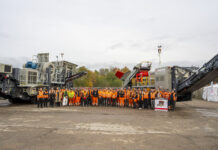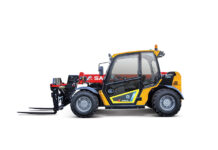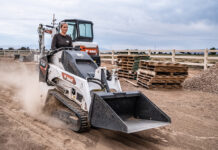JCB is celebrating 60 years of manufacturing backhoe loaders. The company offers a little perspective on choosing an appropriate machine, with reference to its own range. Key milestones in the history of this vehicle category are summarised.

WHEN choosing a backhoe loader, the process naturally begins with a clear assessment of what you require from it. Parameters like lift capacity, digging depth and loading height come up for consideration, all of which point to one machine or another. Size, weight and power will be the initial criteria for many. Having made that decision, there are then many options available, such as engine power ratings, transmissions, locking differentials and arm suspension.
JCB offers backhoe loader models in specification levels to suit many industry sectors. From the skid steer-based 1CX, through the compact all-wheel steer 2CX, the popular 3CX line and the equal-sized wheel 4CX, right up to the most powerful 5CX, there is a JCB backhoe loader to suit every application, jobsite and attachment.
JCB’s TorqueLock transmission system is now standard on 109hp (81kW) models of the 3CX and 4CX. When combined with the optional six-speed Autoshift transmission this can contribute to fuel savings of up to 25% and time savings when travelling, of 10%. However if you don’t need higher travel speeds or maximum power for heavy digging, the 74hp (55kW) engine, with its impressive 400Nm of torque, offers excellent excavator performance with lower fuel consumption.
The company has further developed its technology and engineering expertise recently, building the Dieselmax and Ecomax Stage IIIB/Tier 4 Interim diesel engines. This high level of vertical integration has been vital to the continued success of the backhoe loader, allowing JCB to react to changing customer demand and to innovate and to build upon this most popular concept.
This has led to greater advances in productivity, economy and operator comfort, through the use of such technology as lock-up torque converters, offering true 40km/h travel speeds, Advanced Easy Control servo control levers and the fuel-efficient Tier 4i Ecomax engine, which alone can save a customer up to 9% in fuel.
This engine meets the latest emission standards without the need for a Diesel Particulate Filter (DPF) or exhaust after-treatment fluids, resulting in lower cost, efficient operation for customers. In addition, the electronic control systems employed on the latest 3CX Eco allow the operator to carry out all daily checks from within the cab.
If heavy loading and digging performance are priorities, the 3CX Contractor and 4CX models have heavy-duty lift rams for additional breakout and lifting performance. At the rear of the machine owner operators and contractors with a lot of excavator work will also welcome the option of JCB’s Easy and Advanced Easy Control machines, with seat-mounted excavator levers for the ultimate in fingertip control.
Other recent backhoe loader innovations options include a cab pre-heater, that can be set automatically on a timer to pre-heat the engine and warm the cab during the winter months or in cold climates, allowing the operator to simply get in and drive away, without having to clear windscreens and warm the cab before working. There is even a hot drink option for the JCB backhoe loader, a plug-in water heater that can be used to make tea and coffee at break times.
JCB backhoe loaders are now available with the firm’s LiveLink telematic system, offering new levels of operating control and diagnostic opportunity.
Of course the highest specification isn’t right for every application, particularly in the cost-conscious hire market. Scottish rental firm Lomond Plant Hire is very clear in its buying decision and the reasons behind it, opting for a standard 3CX Sitemaster equipped with a number of key options to suit its customer demands. “We try to standardise all of our plant with the same specification, so all of the backhoes have hammer pipework and quick hitches,” says managing director Ross Easton.
Lomond changes its backhoe loaders every two years, which ensures a strong residual value and an excellent return on the company’s investment. Mr Easton added: “While they aren’t actually asking for it yet, the new engines in the 3CX also offer significant savings in fuel for our customers.”
The firm, which is celebrating 25 years in business in 2013, was started by Sandra Easton with four backhoe loaders and two crawler machines. The company now has an extensive fleet of more than 130 operated machines, mainly supplied by local dealer Scot JCB.
“We are based in Falkirk with depots in Glasgow and Edinburgh,” says Mr Easton. “But we are currently looking to expand with sites in Aberdeen and Dundee. Almost 100% of our equipment comes from Scot JCB, as they are a great supplier.”
JCB company founder Joseph Cyril Bamford invented the concept of the backhoe and the first JCB model was manufactured in 1953 after he combined a lightweight backhoe with a Major Load-all tractor loader. It created, for the first time, a single machine which combined a front shovel and rear excavator arm. Since that time, JCB’s backhoe loader has dominated the market that it created and the backhoe remains the fourth most popular machine in terms of global plant equipment sales, despite the evolution of new and competitive products over the past 60 years. By the end of last year JCB had made 500,000 backhoe loaders.
Tim Burnhope, JCB’s Chief Innovation and Growth Officer said: “The backhoe loader is not 60 years old, it’s 60 years young and this iconic machine has only just started its journey. The JCB backhoe will continue to develop and grow. It is a concept that has much to offer going forwards.
“It is a hugely important machine and in the next few years we will see the backhoe loader develop rapidly as a powerful and versatile tool carrier. Because of this versatility it is far more than just a digging machine and our customers are starting to reinvent the backhoe loader for themselves, based on what it can offer as a tool carrying machine.” Mr Burnhope added : “These are exciting times for the backhoe loader and there are many developments on the way. In addition, JCB will concentrate on attachments and ways in which the backhoe loader can provide complete solutions for customers in a wider range of industry sectors.”









